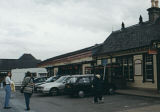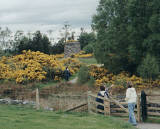Sunday, May 21, 2000
Aviemore
The gray morning was a bright display of sunshine and pale blue sky that seemed to push the clouds well out of the way. The pine trees reached up past the window, their branches encrusted in scales of bark and extended toward the other trees and me as if exchanging greetings. The green was intense against the early morning chill. Droplets of water clung to the outside of the glass and barely interrupted the crystalline view through the woods. I had to open the door and let the sweet air nip my sleepiness.

We boarded the Renault and set off for Aviemore to explore the local area. The business district contained several small shops and restaurants and, except for the market, none of them were much larger than the small mom and pop stores we would see in rural America. The town’s quiet and unsophisticated demeanor betrayed its distinction as a favorite vacation spot in the heart of the Highlands. The only hint we had initially were the several outdoor outfitters that provide equipment and supplies for taking advantage of the nearby Cairngorm Mountains for hiking, skiing, water sports, hunting, fishing, golf, mountain biking, and a number of other activities. We would find many local attractions to occupy our time.
At lunchtime we were passing by Little John’s Restaurant and followed the Guinness signs inside to a pub setting with an electric train rattling by overhead. The lunch experience was more to an American liking I suppose except for the Guinness. I just had to try one. Dark and only slightly cool, its robust flavor first grabbed my tongue with an almost sweet touch followed by a more than pleasant quenching wetness and then quickly changed to an overpowering bitterness. I thought about chugging it so I could move on to something more to my liking but it was a good accompaniment to my lunch. I probably won’t be having another Guinness anytime soon.
Culloden Moor and Inverness
After lunch we took to the North on highway A9 toward Inverness. A stop at Culloden Moor to view the battlegrounds and memorials gave us a long break from riding. It was hard to imaging a raging battle between nearly 5000 Jacobites and 9000 English troops on this marshy mush thick with heather and gorse with its furious yellow blooms. Although the snow in 1746 may have concealed a very different landscape, it would probably have made little difference in the outcome of the battle. The English troops won, denying Bonnie Prince Charlie the crown of Scotland.

Footpaths marbled the vast battleground and led us to markers and monuments that reminded clan members of the angry past and gave visitors an emphatic image of what had been. A network of fences and gates contained a small herd of goats that thrived on whatever it was they found there to eat.
Once again, back to highway A9 and on to Inverness. Off the main highways, narrow roads wind through fields and between houses of rural Scotland. Only a single lane wide, passing areas bubble out frequently on either side to allow oncoming traffic to pass. Curves and hills make progress slow and leave opportunities to take in the variety of crops and beauty of stone fences that seem to travel their own paths across the meadows.
Inverness is a city with a population of about 42,000 within its bounds and another 20,000 in its district. The capital of the Highlands guards the mouth of Moray Firth at the end of River Ness. We carefully guided the Renault through the business district. Twice. Because that’s where the road we were on took us. After a brief scurry the second time, we are able to find our way out and back to highway A9 and back to Aviemore.
Our growling stomachs made us turn the car back toward Aviemore and we stopped at Smiffy’s for fish and chips. What I had known as fish and chips was little more than miniature pieces of fish breaded and fried and pretty much look the same anywhere. I felt like I had graduated into an authentic class of gourmet dining when I landed the giant slab of crusty fried fish on the table. The flavor was far better than the hokey frozen hunks of fish I was used to.
Our first day confirmed what we had read in guide books. We followed their advice in packing light to moderate clothing for the time of year. The meager sun warmed the air during the day to around forty-two degrees Fahrenheit from near freezing temperatures at night. This was to be expected in late May. The light jackets we packed were adequate except for a couple of days that required sweaters beneath them.